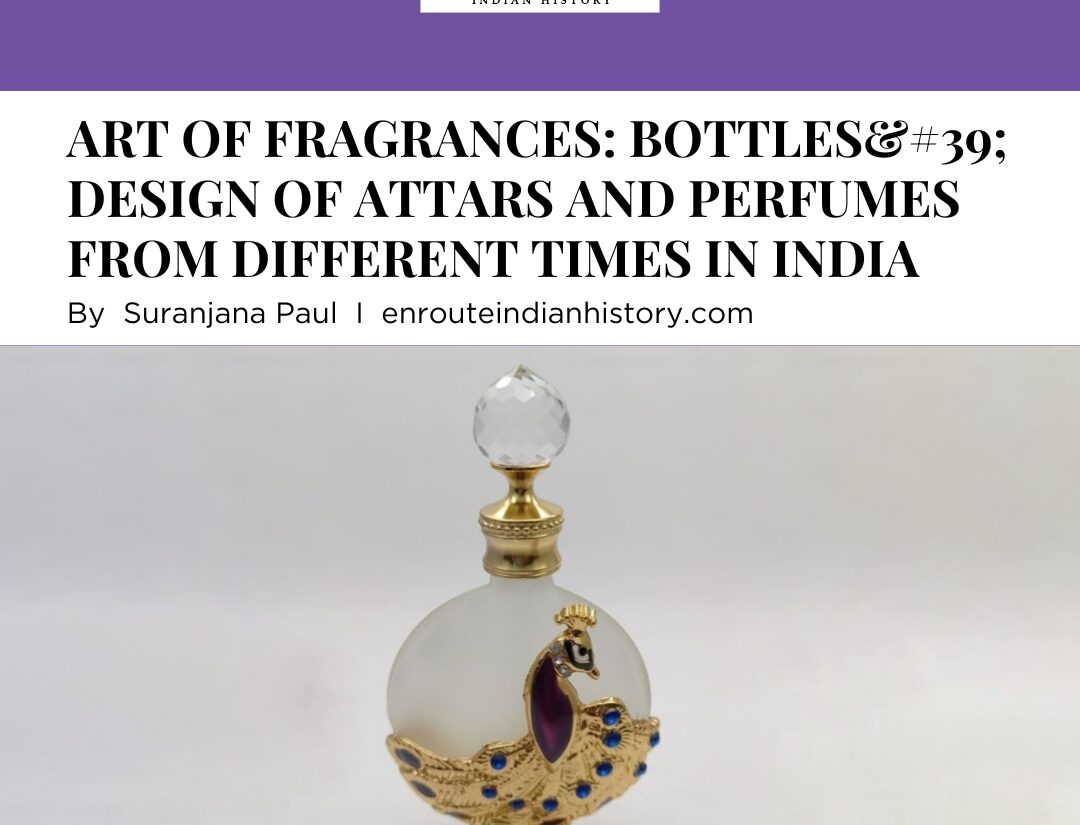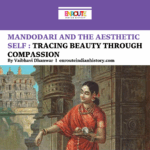Art of Fragrances: Bottles’ design of Attars and Perfumes from different times in India.
- EIH User
- July 26, 2024

Art of Fragrances: Bottles’ design of Attars and Perfumes from different times in India.

I am starting the article by sharing my first experience with perfumes and attars. I was not that kind of person who was passionate about perfumes or fragrances, rather I hated any type of fragrance product but from the last puja, I have started liking it because of the design of the perfume bottles. It sounds weird that a person suddenly started liking perfumes because of the bottles but it happened to me. I bought three bottles of perfumes because of their designs and shapes and I was also amused after entering the shop for the design of the perfume bottles, that day for the first time I noticed the detailed craft of the perfume bottle. Detailed design, and craft is very important for the marketing of the perfume along with the fragrance. Smelling good is not only luxury but also essential to present oneself, especially in the present world, similarly a good design of a bottle seems luxurious but it is also essential for promoting the product. The design of the perfume bottles is also an art that we found from ancient times all over the world as well as in India.
In India, perfume or attar bottles are not only containers of fragrances; they are also pieces of art that are related to the tradition of India. Mughal emperors were fond of perfumes. During the Akbar regime, he established Khushbukhanah, a separate perfumery department to serve the royal court and the imperial requirement for aromatics. Abul Fazl devoted a chapter to the various perfume ingredients, their costs, preparation techniques, and related technology in the book Ain-i Akbari, the second part of Akbarnama, where he provided a detailed and magnificent account of Akbar‘s reign. In addition, during the 17th century Bayaz-i Khwushbui, The Notebook of Fragrance provides essential pieces of information regarding the traditional techniques which were used in the Mughal period to produce perfumes and its seventeen sections dar-i itryat is one of the sections which is devoted to the techniques of perfume making and that was also copied with certain modification from the Akbarnama. Even the bottles were exclusively made for specific attars and the craftsmanship of the bottles demonstrated the level of artistic ability of the era. Expensive and precious materials were used to store or collect the perfume. Apart from storing or collecting the attars, they used high-level materials like glass bottles, metal trays, porcelain plates, and cups with expensive materials for sprinkling, distributing, and gifting the perfumes or attars. Some particular attars like Itr-i Jahāngīrī and Argaja were carried in silver or gold cups and salvers with covers or those were also poured into the huge crystal hookahs for the purpose of gift-giving events or rituals or just to provide as presents for themselves. For special occasions, Mughals in the imperial court of Lahore used several containers and braziers to burn the perfume in the enclosed hollow spaces of the gilt and silver pedestals which were created on the bases of the hall’s four silver-pillared columns. The hall was full of various large perfume holders and braziers which were made of silver and displayed exquisite craftsmanship. Mughals used precious gemstones like rubies and emeralds for the design of the attar bottles along with the silver and gold which exhibited the craftsmanship of that time. They crafted the attar daan or the boxes with priceless gems like lapis and lazuli and filled them with the fragrance of musk which were also expensive and rare items and were used as a gift to the envoy of Bulk.
Attars have a deep relationship with the royal courts of India. Apart from the Mughals, Nizams of Hyderabad are also fond of Attar, they use it as a symbol of luxury and refinement. The Nizams had a remarkable collection of attar bottles which were crafted from fine materials like crystal, gold, and silver. The design of attar bottles not only exhibited the opulent lifestyle but also showcased the artwork of the time. Along with personal use, these attars are also used as a gift and also used to show honour and respect. Traditionally, the visitors of the royal court were welcomed by sprinkling the attar and rosewater.
On the website of the Royal Collection Trust, there are several collections of the attar holders from several provinces, and most of the attar holders were presented to King Edward VII, the Prince of Wales during his India tour from 1875 to 1876 from different Kings. Kharak Singh, the Raja of Kapurthala gifted him a set of Attar bottles which were made of gold in the form of seated lions and holding a projecting spout between their foreleges. The design of the attar bottles was crafted perfectly. Chamarajendra Wadiyar X, Maharaja of Mysore presented him an attar daan which was beautifully crafted with the bird. The Raj Sahib of Wankaner, Banesinhji Jaswantsinhji gifted him a gold perfume holder which was a square bottle followed by the flowers’ pattern and crosshatching. In this collection, there is a cup which was made of gold with a cover and saucer and the cup was magnificently designed in a floral decoration. There is also a silver attardaan which was gifted by Tukoji Rao Holkar II, the Maharaja of Indore.
Attar and the attar daan are not only concentrated in the royal families and elite of India. It was also known to the common man. Ittarwala, the seller of Attar, was part of India. From the memory of Sona Singh which was published in the form of an article on the Museum of Material Memory’s website, where she described the attardaan of her grandmother which was made of wood and the box was covered with maroon velvet and there were eight round slots to hold the bottles in the place. In addition, she has mentioned the silver attar daan that her father gifted her for the sake of her grandma’s memory. Although this wooden attar daan is common in India like the glass bottles of attar but designs on the glass are unique.

Attar daan
(Source: Eternal Mewar)

Attar daan
(Source: Eternal Mewar)
There are different kinds of bottles with different designs, structures, colours, and materials in the different stores of Hyderabad, Delhi, Kolkata, Mumbai, and Lucknow, even in online stores attar bottles are found with antique designs. These bottles are in different shapes like an oval or Triangle pattern along with the design of rose or red stones, coated with golden materials, or the glass bottles with a peacock.

(Source: Indiamart)

(Source: Indiamart)
Along with attar, perfumes are also popular in India. Even the perfumes are more popular among Indian people. Designs of the perfume bottles are varied by the company still they are also found in different designs like attar bottles. Instead of jumping into the evolution of perfume bottles in India, we can shift our eyes to the familiar perfumes in present days for all and the design of the perfume bottles.
The secret temptation is that one which is affordable as well as known to the Indian people. The Designs of the fragrances of romance, dream, or bliss are slightly in different shapes like the Nina Ricci which is quite expensive but found in different unique shapes like the apple or the diamond-designed Lady Million perfumes. Stilettos shaped Carolina Herrera Good Girl are also found in markets with a quite high price like Gucci perfumes which are designed as simple, but elegance and sophistication are present in the design of the perfume bottles.

(Source: Beauty 24)

(Source: Parcos)

(Source: The Perfume Society)
The design of perfume bottles is not only luxurious but it also attracts the customers. The art of the perfume bottle is coming out from the ages and the design of the perfume bottles is as important as fragrances like attar bottles.
Reference:
Chattopadhyay, A., 2023. Indo-Islamicate Perfumes in Early Modern India: Textualisation, Transmissions and Assimilations. The Medieval History Journal, 26(2), pp.314-352. Available from: https://doi.org/10.1177/09719458231206883. (Accessed 20 July 2024)
Sharma. S., 2023. THE ITTARS OF HYDERABAD AND THEIR NIZAMI CONNECTION. Enroute Indian History. 4 September 2023. Available from: https://enrouteindianhistory.com/the-ittars-of-hyderabad-and-their-nizami-connection/ (Accessed 20 July 2024)
Singh. S., 2018. A Whiff of Ittar. Museum of Material Memory. 18 December 2018. Available from: A whiff of ittar – Museum of Material Memory. (Accessed 20 July 2024)

















